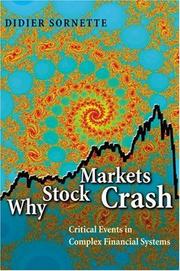| Listing 1 - 10 of 40 | << page >> |
Sort by
|
Book
ISBN: 9781400885091 1400885094 0691175950 9780691175959 Year: 2017 Publisher: Princeton, NJ
Abstract | Keywords | Export | Availability | Bookmark
 Loading...
Loading...Choose an application
- Reference Manager
- EndNote
- RefWorks (Direct export to RefWorks)
Book
Year: 2017 Publisher: Princeton, [New Jersey] ; Oxford, [England] : Princeton University Press,
Abstract | Keywords | Export | Availability | Bookmark
 Loading...
Loading...Choose an application
- Reference Manager
- EndNote
- RefWorks (Direct export to RefWorks)
The scientific study of complex systems has transformed a wide range of disciplines in recent years, enabling researchers in both the natural and social sciences to model and predict phenomena as diverse as earthquakes, global warming, demographic patterns, financial crises, and the failure of materials. In this book, Didier Sornette boldly applies his varied experience in these areas to propose a simple, powerful, and general theory of how, why, and when stock markets crash. Most attempts to explain market failures seek to pinpoint triggering mechanisms that occur hours, days, or weeks before the collapse. Sornette proposes a radically different view: the underlying cause can be sought months and even years before the abrupt, catastrophic event in the build-up of cooperative speculation, which often translates into an accelerating rise of the market price, otherwise known as a "bubble." Anchoring his sophisticated, step-by-step analysis in leading-edge physical and statistical modeling techniques, he unearths remarkable insights and some predictions--among them, that the "end of the growth era" will occur around 2050. Sornette probes major historical precedents, from the decades-long "tulip mania" in the Netherlands that wilted suddenly in 1637 to the South Sea Bubble that ended with the first huge market crash in England in 1720, to the Great Crash of October 1929 and Black Monday in 1987, to cite just a few. He concludes that most explanations other than cooperative self-organization fail to account for the subtle bubbles by which the markets lay the groundwork for catastrophe. Any investor or investment professional who seeks a genuine understanding of looming financial disasters should read this book. Physicists, geologists, biologists, economists, and others will welcome Why Stock Markets Crash as a highly original "scientific tale," as Sornette aptly puts it, of the exciting and sometimes fearsome--but no longer quite so unfathomable--world of stock markets.
Stocks --- Financial crises --- Prices --- History. --- United States. --- Asia. --- Black Monday. --- Dow Jones Industrial Average. --- Hong Kong. --- Latin America. --- Louis Bachelier. --- Nasdaq index. --- Nasdaq. --- Nikkei. --- Russia. --- South Sea bubble. --- anti-imitation. --- antibubble. --- arbitrage opportunities. --- bubble. --- collapse. --- complex systems. --- computational methods. --- cooperative behavior. --- cooperative speculation. --- crash hazard. --- currency crash. --- derivatives. --- discrete scale invariance. --- drawdown. --- efficient market. --- emergent markets. --- extreme events. --- financial crashes. --- finite-time singularity. --- forward prediction. --- fractals. --- free lunch. --- gold. --- hazard rate. --- hedging. --- herding. --- imitation. --- insurance portfolio. --- log-periodicity. --- market failure. --- natural scientists. --- outlier. --- population dynamics. --- positive feedback. --- power law. --- prediction. --- price-driven model. --- random walk. --- rational agent. --- renormalization group. --- returns. --- risk-driven model. --- risk. --- self-organization. --- self-similarity. --- social network. --- social scientists. --- speculative bubble. --- stock market crash. --- stock market indices. --- stock market prices. --- stock market. --- superhumans. --- sustainability. --- tronics boom. --- tulip mania. --- world economy.

ISBN: 0691096309 1400873126 9786612157400 0691118507 128215740X 1400829550 9780691118505 9780691096308 Year: 2009 Publisher: Princeton, NJ : Princeton University Press,
Abstract | Keywords | Export | Availability | Bookmark
 Loading...
Loading...Choose an application
- Reference Manager
- EndNote
- RefWorks (Direct export to RefWorks)
The scientific study of complex systems has transformed a wide range of disciplines in recent years, enabling researchers in both the natural and social sciences to model and predict phenomena as diverse as earthquakes, global warming, demographic patterns, financial crises, and the failure of materials. In this book, Didier Sornette boldly applies his varied experience in these areas to propose a simple, powerful, and general theory of how, why, and when stock markets crash. Most attempts to explain market failures seek to pinpoint triggering mechanisms that occur hours, days, or weeks before the collapse. Sornette proposes a radically different view: the underlying cause can be sought months and even years before the abrupt, catastrophic event in the build-up of cooperative speculation, which often translates into an accelerating rise of the market price, otherwise known as a "bubble." Anchoring his sophisticated, step-by-step analysis in leading-edge physical and statistical modeling techniques, he unearths remarkable insights and some predictions--among them, that the "end of the growth era" will occur around 2050. Sornette probes major historical precedents, from the decades-long "tulip mania" in the Netherlands that wilted suddenly in 1637 to the South Sea Bubble that ended with the first huge market crash in England in 1720, to the Great Crash of October 1929 and Black Monday in 1987, to cite just a few. He concludes that most explanations other than cooperative self-organization fail to account for the subtle bubbles by which the markets lay the groundwork for catastrophe. Any investor or investment professional who seeks a genuine understanding of looming financial disasters should read this book. Physicists, geologists, biologists, economists, and others will welcome Why Stock Markets Crash as a highly original "scientific tale," as Sornette aptly puts it, of the exciting and sometimes fearsome--but no longer quite so unfathomable--world of stock markets. Some images inside the book are unavailable due to digital copyright restrictions.
Stock exchanges --- Stocks --- Financial crises --- Complexity (Philosophy) --- Critical phenomena (Physics) --- History --- Prices --- -Stocks --- -Financial crises --- -Stock exchanges --- -Critical phenomena (Physics) --- 332.63222 --- Philosophy --- Emergence (Philosophy) --- Phenomena, Critical (Physics) --- Physics --- Bulls and bears --- Commercial corners --- Corners, Commercial --- Equity markets --- Exchanges, Securities --- Exchanges, Stock --- Securities exchanges --- Stock-exchange --- Stock markets --- Capital market --- Efficient market theory --- Speculation --- Crashes, Financial --- Crises, Financial --- Financial crashes --- Financial panics --- Panics (Finance) --- Stock exchange crashes --- Stock market panics --- Crises --- Business cycles --- Common shares --- Common stocks --- Equities --- Equity capital --- Equity financing --- Shares of stock --- Stock issues --- Stock offerings --- Stock trading --- Trading, Stock --- Securities --- Bonds --- Corporations --- Going public (Securities) --- Stock repurchasing --- Stockholders --- -History --- History. --- Phénomène critique (Physique) --- Phénomène critique (Physique) --- Critical phenomena (Physics). --- Stock exchanges. --- Forecasting. --- Mathematical models. --- Crises financières --- Bourse --- Histoire --- Modèles mathématiques --- Prévision --- Stock exchanges - United States - History --- Stocks - Prices - History --- Financial crises - United States - History --- Financial crises - History

ISBN: 3540674624 3662041766 366204174X Year: 2000 Publisher: New York, NY ; Berlin : Springer-Verlag,
Abstract | Keywords | Export | Availability | Bookmark
 Loading...
Loading...Choose an application
- Reference Manager
- EndNote
- RefWorks (Direct export to RefWorks)
Concepts, methods and techniques of statistical physics in the study of correlated, as well as uncorrelated, phenomena are being applied ever increasingly in the natural sciences, biology and economics in an attempt to understand and model the large variability and risks of phenomena. This is the first textbook written by a well-known expert that provides a modern up-to-date introduction for workers outside statistical physics. The emphasis of the book is on a clear understanding of concepts and methods, while it also provides the tools that can be of immediate use in applications. Although this book evolved out of a course for graduate students, it will be of great interest to researchers and engineers, as well as to post-docs in geophysics and meteorology.
Critical phenomena (Physics) --- Critical phenomena (Physics). --- Statistical physics. --- Dynamical systems. --- Game theory. --- Earth sciences. --- Complex Systems. --- Game Theory, Economics, Social and Behav. Sciences. --- Earth Sciences, general. --- Statistical Physics and Dynamical Systems. --- Geosciences --- Environmental sciences --- Physical sciences --- Games, Theory of --- Theory of games --- Mathematical models --- Mathematics --- Dynamical systems --- Kinetics --- Mechanics, Analytic --- Force and energy --- Mechanics --- Physics --- Statics --- Mathematical statistics --- Statistical methods

ISBN: 3540308822 9783540308829 3540407545 3540331824 Year: 2006 Publisher: Berlin, Heidelberg : Springer Berlin Heidelberg : Imprint: Springer,
Abstract | Keywords | Export | Availability | Bookmark
 Loading...
Loading...Choose an application
- Reference Manager
- EndNote
- RefWorks (Direct export to RefWorks)
Concepts, methods and techniques of statistical physics in the study of correlated, as well as uncorrelated, phenomena are being applied ever increasingly in the natural sciences, biology and economics in an attempt to understand and model the large variability and risks of phenomena. This is the first textbook written by a well-known expert that provides a modern up-to-date introduction for workers outside statistical physics. The emphasis of the book is on a clear understanding of concepts and methods, while it also provides the tools that can be of immediate use in applications. Although this book evolved out of a course for graduate students, it will be of great interest to researchers and engineers, as well as to post-docs in geophysics and meteorology.
Critical phenomena (Physics) --- Geography. --- Mathematics. --- Statistical physics. --- Complex Systems. --- Earth Sciences, general. --- Game Theory, Economics, Social and Behav. Sciences. --- Statistical Physics and Dynamical Systems. --- Physics --- Mathematical statistics --- Math --- Science --- Cosmography --- Earth sciences --- World history --- Statistical methods --- Critical phenomena (Physics). --- Dynamical systems. --- Earth sciences. --- Game theory. --- Games, Theory of --- Theory of games --- Mathematical models --- Mathematics --- Geosciences --- Environmental sciences --- Physical sciences --- Dynamical systems --- Kinetics --- Mechanics, Analytic --- Force and energy --- Mechanics --- Statics
Digital
ISBN: 9783540331827 Year: 2006 Publisher: Berlin, Heidelberg Springer-Verlag Berlin Heidelberg
Abstract | Keywords | Export | Availability | Bookmark
 Loading...
Loading...Choose an application
- Reference Manager
- EndNote
- RefWorks (Direct export to RefWorks)
Operational research. Game theory --- Mathematics --- Statistical physics --- Geology. Earth sciences --- Computer science --- neuronale netwerken --- chaos --- statistiek --- speltheorie --- wiskunde --- geografie --- fysica
Book
Year: 1999
Abstract | Keywords | Export | Availability | Bookmark
 Loading...
Loading...Choose an application
- Reference Manager
- EndNote
- RefWorks (Direct export to RefWorks)
Book
Year: 1998 Publisher: Amsterdam Elsevier/North-Holland
Abstract | Keywords | Export | Availability | Bookmark
 Loading...
Loading...Choose an application
- Reference Manager
- EndNote
- RefWorks (Direct export to RefWorks)
Book
ISBN: 9781400829552 Year: 2009 Publisher: Princeton, NJ
Abstract | Keywords | Export | Availability | Bookmark
 Loading...
Loading...Choose an application
- Reference Manager
- EndNote
- RefWorks (Direct export to RefWorks)
Book
ISBN: 3319242997 3319243012 Year: 2016 Publisher: Cham : Springer International Publishing : Imprint: Springer,
Abstract | Keywords | Export | Availability | Bookmark
 Loading...
Loading...Choose an application
- Reference Manager
- EndNote
- RefWorks (Direct export to RefWorks)
This book discusses the risks of information concealment in the context of major natural or industrial disasters – offering detailed descriptions and analyses of some 25 historical cases (Three Mile Island nuclear accident, Bhopal disaster, Challenger Space Shuttle explosion, Chernobyl nuclear disaster, Deepwater Horizon oil spill, Fukushima-Daiichi nuclear disaster, Enron’s bankruptcy, Subprime mortgage crisis, Worldwide Spanish flu and SARS outbreaks, etc.) and applying these insights to selected on-going cases where such information concealment is suspected. Some successful examples of preventive anti-concealment practice are also presented. In the book, the term ‘concealment’ is used to represent the two distinct behaviors uncovered in the investigations: (i) facts and information about an organization and its functioning being hidden from those that need them – here the concealment can be due to various factors, such as complexity and miscommunication, to name but two – and (ii) the conscious and deliberate action of keeping important information secret or misrepresenting it. This second meaning makes up a surprisingly important part of the evidence presented. Accordingly, emphasis has been put on this second aspect and the approach is more pragmatic than academic, remaining focused on evidence-based practical and useful factors. It raises awareness and provides valuable lessons for decision- makers, risk specialists and responsible citizens alike. This work is also intended as a fact-based reference work for future academic and scholarly investigations on the roots of the problem, in particular regarding any psychological or sociological modeling of human fallibility. .
Business. --- Business logistics. --- Business ethics. --- Quality control. --- Reliability. --- Industrial safety. --- Pollution prevention. --- Environmental economics. --- Business and Management. --- Supply Chain Management. --- Industrial Pollution Prevention. --- Quality Control, Reliability, Safety and Risk. --- Business Ethics. --- Environmental Economics. --- Disasters --- Disasters. --- Risk management. --- Calamities --- Catastrophes --- Insurance --- Management --- Curiosities and wonders --- Accidents --- Hazardous geographic environments --- Environmental pollution. --- System safety. --- Economics --- Environmental quality --- Business --- Businesspeople --- Commercial ethics --- Corporate ethics --- Corporation ethics --- Professional ethics --- Wealth --- Safety, System --- Safety of systems --- Systems safety --- Industrial safety --- Systems engineering --- Chemical pollution --- Chemicals --- Contamination of environment --- Environmental pollution --- Pollution --- Contamination (Technology) --- Asbestos abatement --- Bioremediation --- Environmental engineering --- Factory and trade waste --- Hazardous waste site remediation --- Hazardous wastes --- In situ remediation --- Lead abatement --- Pollutants --- Refuse and refuse disposal --- Supply chain management --- Industrial management --- Logistics --- Environmental aspects --- Economic aspects --- Moral and ethical aspects --- Prevention --- Industrial accidents --- Industries --- Job safety --- Occupational hazards, Prevention of --- Occupational health and safety --- Occupational safety and health --- Prevention of industrial accidents --- Prevention of occupational hazards --- Safety, Industrial --- Safety engineering --- Safety measures --- Safety of workers --- System safety --- Dependability --- Trustworthiness --- Conduct of life --- Factory management --- Industrial engineering --- Reliability (Engineering) --- Sampling (Statistics) --- Standardization --- Quality assurance --- Quality of products --- Prevention of pollution --- Environmental protection --- Control --- Prevention and control
| Listing 1 - 10 of 40 | << page >> |
Sort by
|

 Search
Search Feedback
Feedback About UniCat
About UniCat  Help
Help News
News